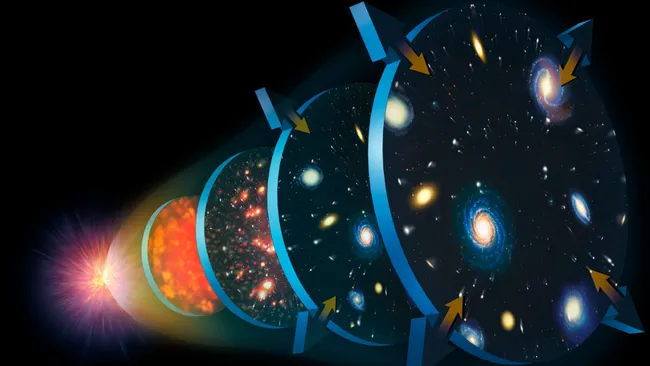The story of the early universe is one of incredible mystery and rapid change. Shortly after the Big Bang, the cosmos underwent a phase of staggering expansion known as cosmic inflation. For decades, scientists believed this expansion was driven by a hypothetical quantum field called the inflaton. However, groundbreaking research now suggests an alternative explanation: inflation may have been powered by the chaotic energy of quantum foam rather than an unknown entity.
What Is Quantum Foam?
At the smallest scales, space and time behave unpredictably, fluctuating due to quantum uncertainty. This phenomenon, known as quantum foam, describes a frothy sea of energy where spacetime is constantly in flux. Quantum foam exists at subatomic levels and is believed to generate minute ripples in spacetime, creating a dynamic foundation for the cosmos.
By examining these fluctuations, researchers propose that quantum foam played a key role in cosmic inflation. Unlike the elusive inflaton field, quantum foam is a well-known aspect of quantum mechanics. It introduces a simpler explanation for the universe’s rapid expansion, using known physics instead of hypothetical entities.
The Traditional Inflation Theory
For over 40 years, the inflaton field has been the cornerstone of inflationary theory. Introduced by physicist Alan Guth in the 1970s, the inflaton was envisioned as a quantum field that powered the universe’s sudden and dramatic growth.
Inflation solved several puzzles in cosmology. For instance, it explains the universe’s flatness—why space appears geometrically flat despite its vastness. It also accounts for the uniformity of the cosmic microwave background (CMB), the faint afterglow of the Big Bang, across vast distances. Most importantly, inflationary models describe how tiny quantum fluctuations were stretched to cosmic scales, laying the groundwork for galaxies and other large structures.
Despite its successes, the inflaton theory has its challenges. Scientists have never identified the inflaton or determined what caused it to stop driving inflation. These gaps leave room for alternative explanations, like the quantum foam model, to emerge.
Inflation Without the Inflaton: A New Model
The new research introduces a paradigm shift: inflation might not need an inflaton field at all. Instead, quantum foam, combined with a cosmological constant (akin to modern dark energy), could have triggered and sustained inflation.
In this model, quantum foam produces gravitational waves, ripples in spacetime that influence the universe’s structure. Under specific conditions, these waves generate the same patterns of large-scale structures seen in the CMB. The result is a universe that matches observed data without requiring an additional quantum field.
While the model doesn’t fully address all inflationary puzzles—such as the flatness problem—it offers a simpler, more elegant framework.
Evidence from the Cosmic Microwave Background
The CMB is a treasure trove of information about the early universe. As the leftover radiation from the Big Bang, it carries imprints of the universe’s initial conditions. Scientists study the CMB to test theories of inflation and the structures it created.
In the quantum foam model, gravitational waves leave subtle but measurable imprints in the CMB. These patterns align with those predicted by inflationary theory, providing indirect support for the idea. While differences between the inflaton-driven and foam-driven models exist, future experiments could determine which one more accurately describes the universe’s infancy.
Why This Discovery Is So Important
Revisiting inflation with this new perspective is more than a theoretical exercise—it reshapes our understanding of the cosmos. The idea that the universe could inflate without introducing new entities simplifies our models, grounding them in observable physics.
This simplicity has profound implications. By eliminating the inflaton, scientists can focus on better understanding quantum mechanics and its role in cosmic evolution. Additionally, the quantum foam model might help bridge the gap between quantum physics and general relativity, two pillars of modern science that often clash at extreme scales.
Challenges of the New Model
While the quantum foam hypothesis is exciting, it is not without its challenges. For example, the model assumes the presence of a strong cosmological constant to sustain rapid expansion. However, the origin and nature of this constant remain unclear.
Additionally, the model does not fully explain why distant regions of the universe have similar properties (the horizon problem) or why the universe appears so flat.
Future Directions in Research
The quantum foam model opens new avenues for exploration. Researchers are already working on several key areas:
- Observational Evidence: Future experiments, like those conducted with advanced gravitational wave detectors, could provide direct evidence of the gravitational waves predicted by this model.
- Comparative Studies: Scientists aim to identify measurable differences between foam-driven inflation and traditional inflation, particularly in the CMB.
- Integration with Other Theories: Efforts to merge quantum mechanics with cosmology could benefit from this framework, offering insights into the universe’s earliest moments.
What This Teaches Us About the Universe
The quantum foam model is a reminder of how much there is to learn about the cosmos. It challenges long-held assumptions and encourages scientists to rethink the fundamental forces that shaped the universe.
More importantly, it underscores the beauty of science: every discovery raises new questions, pushing the boundaries of our knowledge. Whether or not this model proves correct, it highlights the power of curiosity and the relentless quest to understand our place in the cosmos.
Conclusion
The proposal that quantum foam drove the universe’s inflation represents a bold step in cosmology. By offering a simpler alternative to the inflaton field, it challenges traditional models and invites new ways of thinking about the universe’s origins. While questions remain, this hypothesis lays the groundwork for future breakthroughs in our understanding of space, time, and the forces that govern them.
Reference:



















